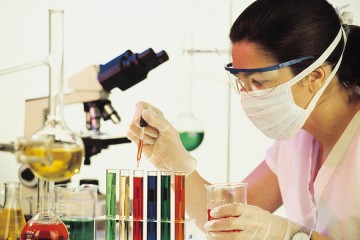In 1893, Florence Bascom became the first woman to earn a PhD from Johns Hopkins University. Three years later, the accomplished geologist became the first woman to work for the U.S. Geological Survey.
During her time studying at Hopkins, though, Bascom was required to sit behind a screen in her classes, so that she did not disturb or distract the male students.
"The barriers faced by many of these women were kind of unbelievable," JHU biophysics Professor Karen Fleming said Tuesday afternoon at the official opening ceremony for the Women of Hopkins exhibit.
Bascom's image is one of 23 larger-than-life portraits the exhibit features on the facade of the Mattin Center on JHU's Homewood campus. An online gallery includes the women's biographies and invites users to nominate future honorees.
Women of Hopkins honors female trailblazers who have made a mark on society during or after their time at Johns Hopkins. The group spans diverse fields including astronomy, biology, music, medicine, and literature, and includes winners of the Nobel Prize, the Grammy, and the MacArthur Genius Grant. Among those featured—former Secretary of State Madeleine Albright; Gail McGovern, president and CEO of the American Red Cross; marine biologist and conservationist Rachel Carson; and Redonda Miller, who in July become the first female president of The Johns Hopkins Hospital.
"This public and visceral celebration of remarkable talent could not come at a better time," said Johns Hopkins University President Ronald J. Daniels at the opening event, alluding to the recent tenor of coverage of the presidential election.
The exhibit grew from a grassroots effort at Johns Hopkins called Achieving Gender Equity in Sciences, a reading and discussion series exploring biases women face in the STEM fields. Fleming is involved as an organizer, along with Dominic Scalise, a doctoral candidate in chemical and biomolecular engineering.
For its capstone event last year, the group brought in Jo Handelsman, who directs science and tech policy for the White House. Her parting words served as inspiration for a visual display, according to Scalise.
Handelson encouraged the group "to use blank spaces on campus to put up art in tribute for some of our amazing female role models," Scalise said in an interview.
Both the discussion group itself and the Women in Hopkins exhibit—which will be in place for at least a year, perhaps (organizers hope) longer—won the support of a Diversity Innovation Grant through the Idea Lab Challenge. The Diversity Leadership Council administers the innovation grants and has helped with the exhibit. Hopkins librarians and archivists also contributed to researching the women of note.
Looking forward, the gender equity group hopes to gather some of the contemporary honorees of Women of Hopkins for an on-campus event in March, to coincide with the 2017 Women's History Month.
One honoree was present yesterday to cut the ceremonial ribbon: Gail Kelly, an advocate for HIV/AIDS policy and education who now works as a senior officer for the U.S. Health Resources and Services Administration. In 1970, Kelly was among the first three black female undergraduates to enroll at Johns Hopkins.
As much as Women of Hopkins celebrates past and current accomplishments, organizers emphasized that the exhibit is also meant as a source of future inspiration. Its slogan is: "Know Them. Join Them."
"Role models are a way forward," Fleming said.
Posted in Arts+Culture, University News, Politics+Society
Tagged diversity










